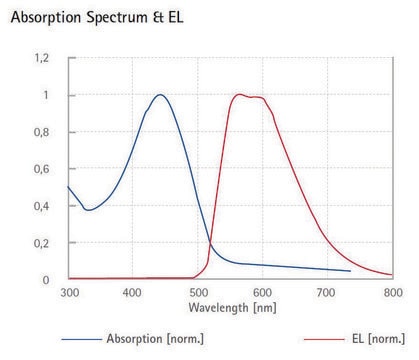Products may be shipped at a different temperature than the recommended long-term storage temperature. If the product quality is sensitive to short-term exposure to conditions other than the recommended long-term storage, it will be shipped on wet or dry-ice. If the product quality is NOT affected by short-term exposure to conditions other than the recommended long-term storage, it will be shipped at ambient temperature. As shipping routes are configured for minimum transit times, shipping at ambient temperature helps control shipping costs for our customers. For more information, please refer to the Storage and Transport Conditions document: https://www.sigmaaldrich.com/deepweb/assets/sigmaaldrich/marketing/global/documents/316/622/storage-transport-conditions-mk.pdf
541443
Poly[2-methoxy-5-(2-ethylhexyloxy)-1,4-phenylenevinylene]
average Mn 40,000-70,000
Synonym(s):
MEH-PPV
About This Item
Recommended Products
description
Band gap: 2.3 eV
mol wt
average Mn 40,000-70,000
fluorescence
λex 493 nm; λem 554 nm in toluene
Orbital energy
HOMO -5.3 eV
LUMO -3 eV
OLED Device Performance
ITO/PEDOT:PSS/MEH-PPV/Al
- Color: orange-red
- Max. Luminance: 220 Cd/m2
- Max. EQE: 0.3 %
- Turn-On Voltage: 3.8 V
ITO/PEDOT:PSS/MEH-PPV/PBO/Al
- Color: orange-red
- Max. Luminance: 970 Cd/m2
- Max. EQE: 1.9 %
- Turn-On Voltage: 2.9 V
ITO/PEDOT:PSS/MEH-PPV/PBZT/Al
- Color: orange-red
- Max. Luminance: 1400 Cd/m2
- Max. EQE: 2.5 %
- Turn-On Voltage: 2.8 V
OPV Device Performance
ITO/MEH-PPV/BBL/Al
- Short-circuit current density (Jsc): 1.98 mA/cm2
- Open-circuit voltage (Voc): 0.93 V
- Fill Factor (FF): 0.47
- Power Conversion Efficiency (PCE): 1.1 %
ITO/MEH-PPV:PC61BM(1:4)/Ca
- Short-circuit current density (Jsc): 2 mA/cm2
- Open-circuit voltage (Voc): 0.8 V
- Fill Factor (FF): 0.25
- Power Conversion Efficiency (PCE): 1.5 %
Mw/Mn
~6
storage temp.
2-8°C
SMILES string
O(CC(CCCC)CC)c1cc(c(cc1)OC)C=C
InChI
1S/C17H26O2/c1-5-8-9-14(6-2)13-19-16-10-11-17(18-4)15(7-3)12-16/h7,10-12,14H,3,5-6,8-9,13H2,1-2,4H3
InChI key
CTUSWJPWMNVXEE-UHFFFAOYSA-N
Related Categories
General description
Application
Filter before application.
Storage Class Code
11 - Combustible Solids
WGK
WGK 3
Flash Point(F)
Not applicable
Flash Point(C)
Not applicable
Personal Protective Equipment
Choose from one of the most recent versions:
Already Own This Product?
Find documentation for the products that you have recently purchased in the Document Library.
Articles
PCBM-based n-type semiconductors - Find p- and n-type organic semiconductors available with PCBM library & properties.
PCBM-based n-type semiconductors - Find p- and n-type organic semiconductors available with PCBM library & properties.
PCBM-based n-type semiconductors - Find p- and n-type organic semiconductors available with PCBM library & properties.
PCBM-based n-type semiconductors - Find p- and n-type organic semiconductors available with PCBM library & properties.
-
How is shipping temperature determined? And how is it related to the product storage temperature?
1 answer-
Helpful?
-
-
How can I determine the shelf life / expiration / retest date of this product?
1 answer-
If this product has an expiration or retest date, it will be shown on the Certificate of Analysis (COA, CofA). If there is no retest or expiration date listed on the product's COA, we do not have suitable stability data to determine a shelf life. For these products, the only date on the COA will be the release date; a retest, expiration, or use-by-date will not be displayed.
For all products, we recommend handling per defined conditions as printed in our product literature and website product descriptions. We recommend that products should be routinely inspected by customers to ensure they perform as expected.
For products without retest or expiration dates, our standard warranty of 1 year from the date of shipment is applicable.
For more information, please refer to the Product Dating Information document: https://www.sigmaaldrich.com/deepweb/assets/sigmaaldrich/marketing/global/documents/449/386/product-dating-information-mk.pdfHelpful?
-
-
do you have molecular weight characterization data for your Poly[2-methoxy-5-(2’-ethylhexyloxy)-1,4-phenylene vinylene] samples?
1 answer-
As listed in the 'PROPERTIES' section, the average molecular weight of this product is 40,000-70,000.
Helpful?
-
-
What is the glass transition temperature (Tg) of Product 541443, Poly[2-methoxy-5-(2-ethylhexyloxy)-1,4-phenylenevinylene]?
1 answer-
Unfortunately, the glass transition temperature (Tg) is not determined for this product.
Helpful?
-
-
What is the solubility of Product 541443, Poly[2-methoxy-5-(2-ethylhexyloxy)-1,4-phenylenevinylene]?
1 answer-
Per our quality control testing, this product is soluble in toluene with heat and sonication at a concentration of 0.02 g/L.
Helpful?
-
-
Does Product 541443, Poly[2-methoxy-5-(2-ethylhexyloxy)-1,4-phenylenevinylene], contain a dopant?
1 answer-
This product does not contain a dopant.
Helpful?
-
-
What is the Department of Transportation shipping information for this product?
1 answer-
Transportation information can be found in Section 14 of the product's (M)SDS.To access the shipping information for this material, use the link on the product detail page for the product.
Helpful?
-
-
Can Product 541443, Poly[2-methoxy-5-(2-ethylhexyloxy)-1,4-phenylenevinylene], efficiently convert light to electricity?
1 answer-
The polyphenylenevinylene (PPV) polymers themselves do not convert light to electricity very efficiently. They need to be blended with an electron transport material. The best material for this is a fullerene material called [6,6]-Phenyl C61 butyric acid methyl ester (PCBM, offered as #684430, 684449, 684457). There are several references that discuss polymer-fullerene heterojunctions. One paper on this subject is Brabec, C.J.; et. al. Applied Physics Letters, 80, 1288 (2002).
Helpful?
-
Active Filters
Our team of scientists has experience in all areas of research including Life Science, Material Science, Chemical Synthesis, Chromatography, Analytical and many others.
Contact Technical Service![Poly[2-methoxy-5-(2-ethylhexyloxy)-1,4-phenylenevinylene] average Mn 70,000-100,000](/deepweb/assets/sigmaaldrich/product/structures/344/488/b8f8179d-3970-4deb-a754-adda88cdb36f/640/b8f8179d-3970-4deb-a754-adda88cdb36f.png)
![Poly[(p-phenylenevinylene)-alt-(2-methoxy-5-(2-ethylhexyloxy)-p-phenylenevinylene)]](/deepweb/assets/sigmaaldrich/product/structures/147/963/61b421da-530b-4acf-8851-ecb9492e90ba/640/61b421da-530b-4acf-8851-ecb9492e90ba.png)


![Poly[(m-phenylenevinylene)-co-(2,5-dioctoxy-p-phenylenevinylene)] light-emitting polymer, predominantly trans](/deepweb/assets/sigmaaldrich/product/structures/249/040/9442b889-4fa0-4b4a-b424-cff0769a5ef2/640/9442b889-4fa0-4b4a-b424-cff0769a5ef2.png)




